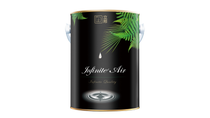Sustainability
Cleaner indoor air – with a low carbon footprint, too

The need: a superior, more sustainable paint
When Nippon Paint set out to create a new interior paint for the Chinese market, they partnered with BASF.
Nippon Paint, the leading coating manufacturer in Asia, was looking for new sustainable raw materials to develop environmentally-friendly paints. In 2017, BASF presented them the Biomass Balance Approach on how to produce dispersions for paints using renewable raw materials. The company was impressed by this innovative breakthrough which replaces fossil resources with renewables in order to reduce greenhouse gas emissions.
The solution: ingredients derived from renewable raw materials
Our sustainable innovation perfectly aligns with Nippon Paint’s mission. As a result, a new eco-friendly interior paint Infinite Air was developed by the two market leaders.
In general, dispersions are manufactured from fossil fuels. When BASF’s dispersions are produced with the biomass balance approach, fossil raw materials are replaced with renewable feedstock such as bio-naphtha or biogas derived from biomass, namely plant oils or wood residue. The production process is certified by an independent 3rd party and the sustainability of the biomass feedstock is assured by recognized certification systems. This innovation saves fossil fuel and greenhouse gas, with no compromise on quality.
The result: a paint that’s healthier for people and for the climate
“Nippon Paint is excited to develop this new eco-friendly interior paint together with our raw material provider BASF. As an innovation pioneer in the paint industry in China, it is our responsibility to produce high quality paints in an environmentally-friendly, sustainable manner,” said Tony Tsai, Vice President, Trade Use Unit Decorative Coatings Division Marketing, Nippon Paint.
“With this sustainable method, our latest Infinite Air paint can be produced with dispersions derived from renewable raw materials like sustainable palm oil or residues from Scandinavian wood. Each liter of paint thus helps to conserve fossil resources and reduce overall greenhouse gas emissions. We aim to contribute to sustainable development while offering safe and environmentally friendly interior paint to our customers in China.”
About BASF’s Dispersions & Pigments division
The Dispersions & Pigments division of BASF develops, produces and markets a range of high-quality pigments, resins, additives and polymer dispersions worldwide. These raw materials are used in formulations for coatings and paints, printing and packaging products, construction chemicals, adhesives, fiber bondings, plastics, and paper as well as for electronic applications such as displays. With its comprehensive product portfolio and its extensive knowledge of the industry, the Dispersions & Pigments division offers its customers innovative and sustainable solutions and helps them advance their formulations. For further information about the Dispersions & Pigments division, please visit www.dispersions-pigments.basf.com.
About BASF
At BASF, we create chemistry for a sustainable future. We combine economic success with environmental protection and social responsibility. The more than 115,000 employees in the BASF Group work on contributing to the success of our customers in nearly all sectors and almost every country in the world. Our portfolio is organized into five segments: Chemicals, Performance Products, Functional Materials & Solutions, Agricultural Solutions and Oil & Gas. BASF generated sales of €64.5 billion in 2017. BASF shares are traded on the stock exchanges in Frankfurt (BAS), London (BFA) and Zurich (BAS). Further information at www.basf.com.